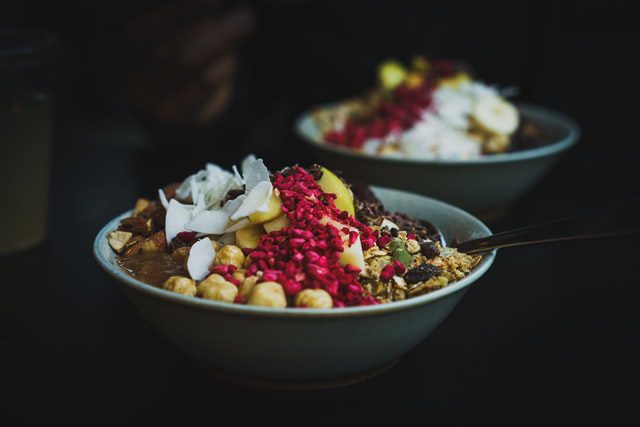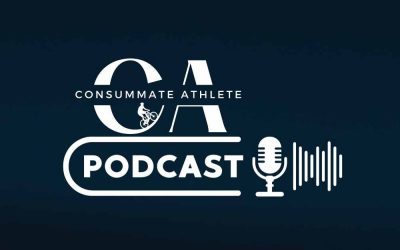As someone who grew up in a house that had a single Pyrex measuring cup that handled all liquid and solid food measurements, and as someone who’s never been great about keeping food journals for more than a day or two, I’m a fan of eyeballing portion sizes. I’m lazy, and also, I realize how easy it is to fall into a food obsession/rabbit hole. But I realize that the ‘eyeball it and hope for the best’ method isn’t great for everyone, and I’ve seen a lot of training camps where people would measure out a ‘serving’ of Greek yogurt that looked more like a tablespoon… and later they would wonder why they weren’t full. So, I’ve been investigating the backs of packages more closely, looking for actual serving size by weight, and then adding it up on my food scale. This isn’t so I can count calories to cut back—it’s so I can better understand what an actual serving looks like so I can make smarter decisions about things like how much protein I need to eat.
And here’s the thing: my ability to eyeball serving sizes is, as it turns out, not great. What was shocking when I did this experiment was that the amounts I *thought* were a serving size were far from it. It takes a lot of Greek yogurt to hit 20 grams of protein. Most protein powders are 2 scoops, not 1. And servings of fruits and veggies are usually bigger than you realize if you go by weight!
(Grab a food scale here if you don’t have one + want to try this—they’re under $15!)
Do: Use a food scale to figure out what a portion size actually looks like
While I love using the hand method for figuring out portion size in a pinch, it’s not always super accurate/easy to gauge with things like yogurt! (A palm of yogurt?) This is a really good method to guarantee that you’re getting serving size correct. It’s also good because you can use the bowls and plates you normally would, put them on the scale and zero it out, then add your food onto your usual bowl so you know what it looks like in the vessel you usually use. It’s much easier to replicate!
Don’t: Feel the need to weigh every single meal, every single time
I don’t want anyone to feel like we’re suggesting you should weigh every ingredient you use in every meal you eat. This is strictly for learning purposes: Once you have a idea of what a serving of a certain food looks like, don’t stress about measuring it again. Eating birthday cake? Don’t weigh it. Enjoy it. Trying to make sure you have 30 grams of protein at lunch post-ride? Weigh it once to see what a serving looks like.
Do: Make sure that you’re eating enough, and leading with vegetables, fruit and protein sources
Again, I wanted to use the scale to make sure that I was getting the serving of protein that I thought I was getting, and not accidentally making it too small! I cannot believe how much yogurt (see below) it took to make a single serving. It is way more than you expect.
Don’t: Get obsessed with every last gram you’re eating
Seriously. A gram here, a gram there—not a big deal. This is just to help you get a big-picture idea of how much yogurt to scoop into your bowl, or how many nuts there are in a single serving.
The Case Study: Greek Yogurt with Blueberries
Just wanted to give a graphic representation of how much yogurt goes into a single serving of Greek Yogurt—the 0% fat variety is a serving size of 175 grams, with 17 grams of protein per serving. So if you’re trying to use it as a protein source, you need to actually eat the whole serving, but most people will scoop a big tablespoon into their bowl and call it good. It’s actually a lot more than that. Between 2 servings of blueberries (about the same in grams as the yogurt for that!) and the yogurt, my large-sized cereal bowl was half-full. (Not pictured: I drizzled maple syrup on here and added some walnuts as well—and this was just a mid-day snack!)

What does this show? First of all, it’s a pretty big bowl of food. It’s much more yogurt than I would normally use if I was scooping on my own. But here’s the other kicker: Even these two things combined are UNDER 100 calories. That’s not even a reasonable SNACK for an athlete after a workout. Adding maple syrup or honey to the mix adds another 150 or so calories, but this alone still isn’t enough to sustain you, especially if it’s your full meal post-workout. Which, for me, it was. I made A LOT of changes after realizing how low I’d been running the tank, without even realizing it.
I don’t think you need to weigh your food every day. But I do think you should see what an actual serving size is—and if you need 2 or 3 of them!
I think this is an experiment worth doing, especially if you are trying to gain or lose weight, or if you’re currently using a meal logging app like MyFitnessPal, since that relies on you knowing that you’re eating the actual serving size. I think it’s an awesome way to check in and ensure that you’re getting the nutrients you need—ESPECIALLY protein, which can definitely be one of the trickier ones!!






